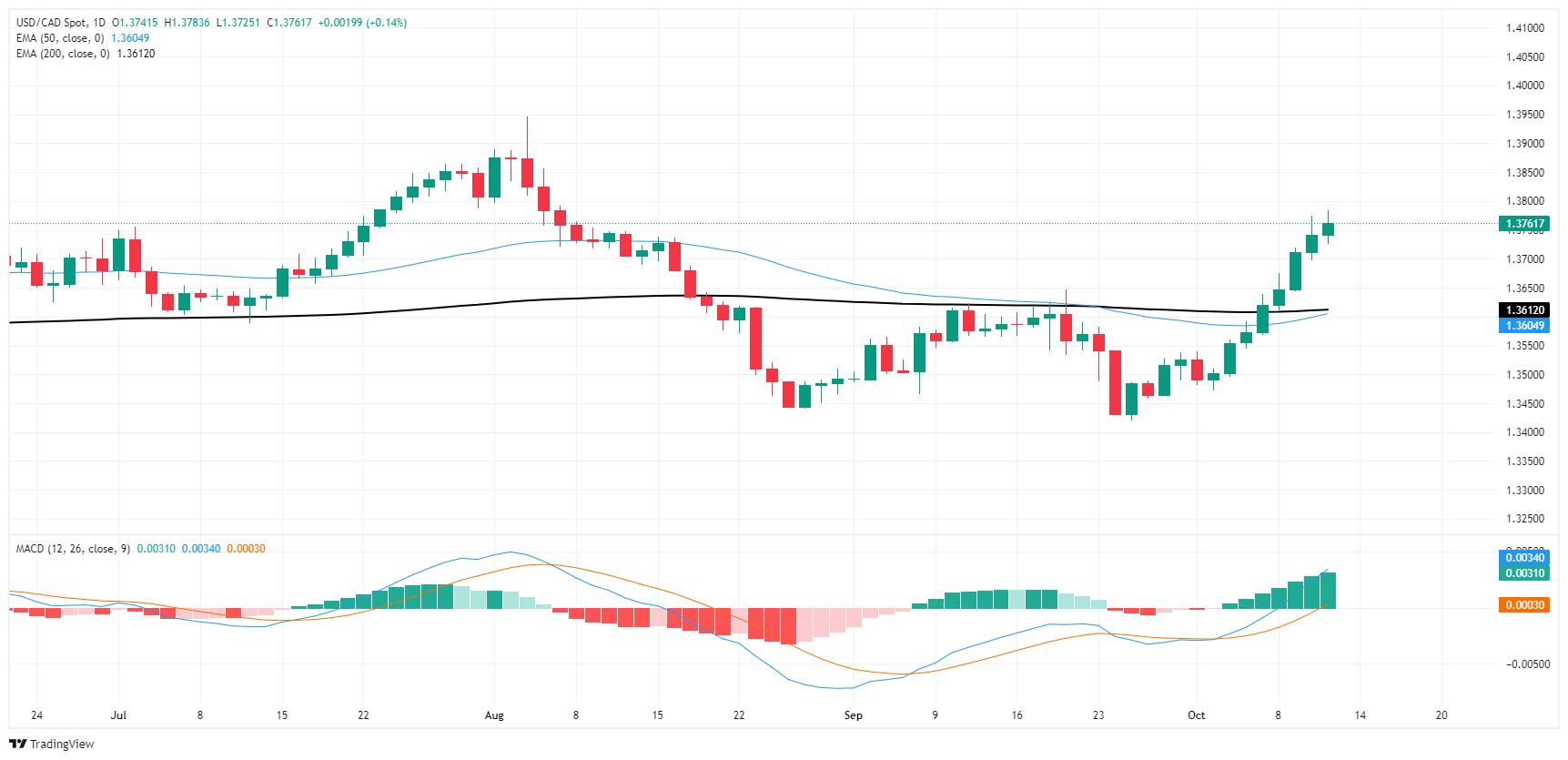- The Canadian Dollar backslid another tenth of a percent against the Greenback.
- Despite upbeat labor data from Canada, markets deferred to the US Dollar.
- US PPI inflation cooled to flat in September, but core PPI remains an issue.
The Canadian Dollar (CAD) fell against the Greenback for an eighth consecutive trading day as markets pivot out of the Loonie in favor of the US Dollar. US Producer Price Index (PPI) inflation cooled more than expected in September, but markets noted that core PPI inflation still ticked higher for the annualized period.
Canada’s labor print did little to bolster the CAD, despite new jobs data nearly doubling forecasts. Canada’s Unemployment Rate also ticked down, flaunting market expectations of another move higher. With the Bank of Canada (BoC) broadly expected to deliver another 50 bps rate cut at its next policy meeting later in the month, markets have little reason to bid up the CAD. The Loonie is now poised for its worst week against the Greenback since March of 2023.
Daily digest market movers
- Canada added 46.7K net new jobs in September, nearly double the median market forecast of 27K, compared to August’s 22.1K.
- Canada’s Unemployment Rate also ticked down to 6.5% from 6.6%, reversing the expected uptick to 6.7%.
- Despite upbeat labor figures, the BoC is still expected to cut rates by another 50 bps on October 23.
- US PPI inflation flatted in September, cooling to a flat 0.0% MoM compared to the expected 0.1% and August’s 0.2%.
- September’s YoY PPI print chilled less than expected, printing at 1.8% versus the expected 1.6%, but still came in under August’s revised print of 1.9%.
- Core PPI inflation, excluding food and energy prices, actually rose to 2.8% YoY in September, over and above the anticipated 2.7%. August’s annualized PPI figure was also revised to 2.6% from the initial print of 2.4%.
Canadian Dollar price forecast
The USD/CAD currency pair continued its recent upward momentum, closing at 1.3762, up 0.15% for the day. The pair has rallied sharply over the past week, recovering from September’s lows near 1.3400. As seen in the chart, the price action is well above the 50-day exponential moving average (EMA) at 1.3605 and the 200-day EMA at 1.3612, indicating a shift toward a more bullish outlook. The pair broke above these key moving averages at the beginning of October, confirming a breakout from the downtrend that had dominated throughout August and September.
Momentum indicators support the recent bullish reversal. The Moving Average Convergence Divergence (MACD) indicator has turned positive, with the MACD line crossing above the signal line. The histogram is steadily increasing, showing growing bullish momentum. With MACD readings now in positive territory, the outlook suggests that further gains are likely in the near term, with the next key resistance level around 1.3800, a psychological and technical barrier that traders are likely to monitor closely.
However, the recent rally has left the pair overextended in the short term, as indicated by the rapid pace of gains over the last few sessions. A pullback to test the 50-day EMA or the 1.3650 level could be possible before the pair attempts to break higher. Overall, the trend appears to have shifted in favor of the USD, but traders should keep an eye on upcoming economic data and any signs of exhaustion in the bullish momentum to manage potential volatility.
USD/CAD daily chart
Canadian Dollar FAQs
The key factors driving the Canadian Dollar (CAD) are the level of interest rates set by the Bank of Canada (BoC), the price of Oil, Canada’s largest export, the health of its economy, inflation and the Trade Balance, which is the difference between the value of Canada’s exports versus its imports. Other factors include market sentiment – whether investors are taking on more risky assets (risk-on) or seeking safe-havens (risk-off) – with risk-on being CAD-positive. As its largest trading partner, the health of the US economy is also a key factor influencing the Canadian Dollar.
The Bank of Canada (BoC) has a significant influence on the Canadian Dollar by setting the level of interest rates that banks can lend to one another. This influences the level of interest rates for everyone. The main goal of the BoC is to maintain inflation at 1-3% by adjusting interest rates up or down. Relatively higher interest rates tend to be positive for the CAD. The Bank of Canada can also use quantitative easing and tightening to influence credit conditions, with the former CAD-negative and the latter CAD-positive.
The price of Oil is a key factor impacting the value of the Canadian Dollar. Petroleum is Canada’s biggest export, so Oil price tends to have an immediate impact on the CAD value. Generally, if Oil price rises CAD also goes up, as aggregate demand for the currency increases. The opposite is the case if the price of Oil falls. Higher Oil prices also tend to result in a greater likelihood of a positive Trade Balance, which is also supportive of the CAD.
While inflation had always traditionally been thought of as a negative factor for a currency since it lowers the value of money, the opposite has actually been the case in modern times with the relaxation of cross-border capital controls. Higher inflation tends to lead central banks to put up interest rates which attracts more capital inflows from global investors seeking a lucrative place to keep their money. This increases demand for the local currency, which in Canada’s case is the Canadian Dollar.
Macroeconomic data releases gauge the health of the economy and can have an impact on the Canadian Dollar. Indicators such as GDP, Manufacturing and Services PMIs, employment, and consumer sentiment surveys can all influence the direction of the CAD. A strong economy is good for the Canadian Dollar. Not only does it attract more foreign investment but it may encourage the Bank of Canada to put up interest rates, leading to a stronger currency. If economic data is weak, however, the CAD is likely to fall.
Information on these pages contains forward-looking statements that involve risks and uncertainties. Markets and instruments profiled on this page are for informational purposes only and should not in any way come across as a recommendation to buy or sell in these assets. You should do your own thorough research before making any investment decisions. FXStreet does not in any way guarantee that this information is free from mistakes, errors, or material misstatements. It also does not guarantee that this information is of a timely nature. Investing in Open Markets involves a great deal of risk, including the loss of all or a portion of your investment, as well as emotional distress. All risks, losses and costs associated with investing, including total loss of principal, are your responsibility. The views and opinions expressed in this article are those of the authors and do not necessarily reflect the official policy or position of FXStreet nor its advertisers. The author will not be held responsible for information that is found at the end of links posted on this page.
If not otherwise explicitly mentioned in the body of the article, at the time of writing, the author has no position in any stock mentioned in this article and no business relationship with any company mentioned. The author has not received compensation for writing this article, other than from FXStreet.
FXStreet and the author do not provide personalized recommendations. The author makes no representations as to the accuracy, completeness, or suitability of this information. FXStreet and the author will not be liable for any errors, omissions or any losses, injuries or damages arising from this information and its display or use. Errors and omissions excepted.
The author and FXStreet are not registered investment advisors and nothing in this article is intended to be investment advice.
Recommended content
Editors’ Picks

EUR/USD remains offered in the low-1.0900s
The generalised selling pressure continues to weigh on the risk complex, pushing EUR/USD back toward the 1.0900 support level amid a growing risk-off mood, as traders assess President Trump’s reciprocal tariffs and their impact on economic activity.

GBP/USD retreats further and breaks below 1.2800
The US Dollar is picking up extra pace and flirting with daily highs, sending GBP/USD to multi-week lows near 1.2770 in a context where safe-haven demand continues to dictate sentiment amid the chaos of US tariffs.

Gold slips back below the $3,000 mark
Gold has turned lower, slipping beneath the key $3,000 mark per troy ounce amid a broad sell-off across global equity markets. The decline in the precious metal may reflect investors unwinding long positions in gold to offset mounting losses in stocks.

US stock market suddenly reverses higher after rumor of 90-day tariff pause before sinking again Premium
NASDAQ sinks 4% before shooting higher on tariff pause rumor. CNBC says White House unaware of tariff pause rumor. S&P 500 sinks to January 2024 level. Bank of America cuts its year-end target for S&P 500 by 16%.

Strategic implications of “Liberation Day”
Liberation Day in the United States came with extremely protectionist and inward-looking tariff policy aimed at just about all U.S. trading partners. In this report, we outline some of the more strategic implications of Liberation Day and developments we will be paying close attention to going forward.

The Best brokers to trade EUR/USD
SPONSORED Discover the top brokers for trading EUR/USD in 2025. Our list features brokers with competitive spreads, fast execution, and powerful platforms. Whether you're a beginner or an expert, find the right partner to navigate the dynamic Forex market.



